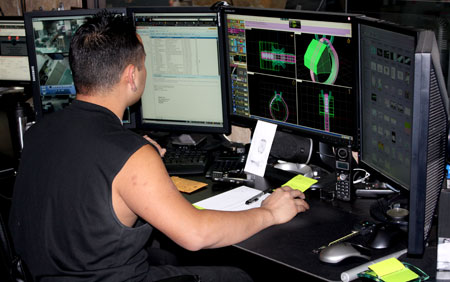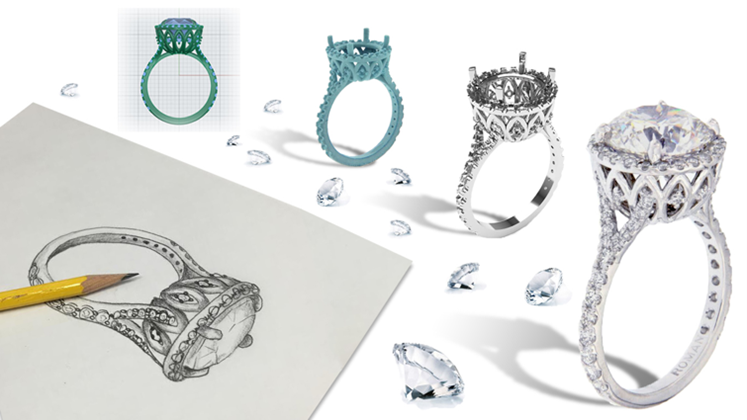Jewelry has always been a symbol of elegance, beauty, and personal expression. From ancient civilizations to modern times, jewelry has captivated people with its intricate designs and exquisite craftsmanship. In today’s digital age, the art of jewelry design has evolved with the introduction of Computer-Aided Design (CAD) technology. This revolutionary tool has transformed the way jewelry is conceptualized, designed, and produced. In this blog, we will delve into the world of a jewelry CAD designer, exploring their role, skills, and the impact they have on the industry.
What is a Jewelry CAD Designer?
A Jewelry CAD Designer is a skilled professional who uses computer-aided design (CAD) software to create intricate and detailed jewelry designs. CAD technology has revolutionized the jewelry industry, allowing designers to bring their ideas to life with precision and efficiency.
The role of a Jewelry CAD Designer involves translating a client’s vision or concept into a digital design. They work closely with jewelers, gemologists, and clients to understand their requirements and preferences. Using CAD software, they can manipulate shapes, sizes, and textures to create unique and stunning designs that meet the client’s expectations.
One of the key advantages of CAD technology in jewelry design is the ability to create 3D models. Jewelry CAD Designers can visualize their designs from different angles and perspectives, ensuring that every intricate detail is accounted for. This allows them to make adjustments and modifications before the actual production process begins, saving time and resources.
Jewelry CAD Designers also have the flexibility to experiment with various materials and gemstones virtually. They can simulate different combinations and settings to determine the most suitable options for a particular design. This not only enhances creativity but also helps clients make informed decisions about their jewelry.
In addition to creating new designs, Jewelry CAD Designers may also be involved in modifying existing designs or replicating antique pieces. They use their expertise and CAD skills to recreate intricate patterns and settings while maintaining the original charm and character of the jewelry.
The role of a Jewelry CAD Designer requires a strong blend of artistic creativity, technical skills, and attention to detail. They must have a solid understanding of jewelry manufacturing processes, materials, and gemstones. Proficiency in CAD software, such as Rhino 3D software or Matrix, is essential for creating accurate and realistic designs.
Skills Required for Jewelry CAD Designer
To excel in this field, a jewelry CAD designer needs to possess a unique blend of artistic and technical skills. Let’s take a look at some of the key skills required to become a successful jewelry CAD designer:
- Artistic Ability: A deep understanding of design principles, aesthetics, and the ability to visualize three-dimensional forms are essential for creating stunning jewelry designs.
- Technical Proficiency: Proficiency in CAD software such as Rhino 3D, Matrix, or JewelCAD is crucial. The designer should be comfortable with the software’s tools and features to bring their designs to life.
- Jewelry Manufacturing Knowledge: Understanding the manufacturing process is vital as it helps the designer create designs that are not only visually appealing but also feasible for production within budget and time constraints.
- Attention to Detail: Jewelry designs require precision, intricate details, and fine finishes. A jewelry CAD designer must have a keen eye for detail to ensure that every element of the design is accurately represented in the virtual model.
- Communication Skills: Effective communication is key in collaborating with clients, jewelers, and manufacturers. The designer should be able to translate client requirements into design concepts and communicate technical specifications to ensure a smooth production process.
- Problem-Solving Abilities: Designing jewelry often involves overcoming challenges and finding creative solutions. A jewelry CAD designer should have strong problem-solving skills to tackle complex design issues and optimize the final product.
Many Jewellery CAD Designer Jobs in Mumbai, Surat, Dubai and other manufacturing centers look for Rhino and Matrix talent.
Impact on the Jewelry Industry
The introduction of CAD technology in the jewelry industry has had a significant impact on various aspects of the business:
Design Exploration and Customization
CAD software allows designers to experiment with different design variations quickly and easily. Clients can visualize and customize their desired pieces before they are manufactured, leading to greater customer satisfaction.
Time and Cost Efficiency
Traditional jewelry design processes involved hand-carving wax models, which were time-consuming and costly. With CAD technology, designers can create virtual models rapidly, reducing production time and costs.
Improved Accuracy and Precision
CAD software enables designers to create precise measurements and intricate details that would be difficult to achieve manually. This level of accuracy ensures that the final product matches the initial design concept perfectly.
Enhanced Collaboration
Jewelry CAD designers can work closely with clients, jewelers, and manufacturers regardless of geographical boundaries. This technology enables seamless communication and collaboration throughout the design and production process.
Preservation of Design Archives
Digital files created through CAD software can be easily stored and retrieved for future reference. This allows designers to build extensive design archives, making it easier to replicate or modify designs based on client preferences.
The Future of Jewelry CAD Design
As technology continues to advance, the future of jewelry CAD design looks promising:
Integration of Artificial Intelligence (AI)
The integration of Artificial Intelligence (AI) in the field of Jewelry CAD Designing has revolutionized the way jewelry is created and designed. With AI, designers can now leverage advanced algorithms and machine learning techniques to enhance their creativity and efficiency.
One significant benefit of integrating AI in Jewelry CAD Designing is the ability to generate unique and innovative designs. AI algorithms can analyze vast amounts of data, including historical trends, customer preferences, and market demands, to suggest new and captivating design ideas. This not only saves time for designers but also helps in creating designs that resonate with customers.
AI also plays a crucial role in improving the accuracy and precision of jewelry designs. By automating repetitive tasks and providing real-time feedback, AI algorithms assist designers in creating intricate and flawless designs. This ensures that the final product meets the highest quality standards.
Furthermore, AI-powered software enables designers to visualize their creations in three-dimensional virtual environments. This immersive experience allows jewelry CAD designers to make adjustments and modifications before the actual production process, reducing the chances of errors and wastage.
Another advantage of AI integration is the ability to optimize the manufacturing process. AI algorithms can analyze production requirements, material availability, and cost constraints to provide efficient production plans. This leads to reduced manufacturing time, minimized material waste, and increased productivity.
3D Printing Revolution
3D printing has revolutionized various industries, and one area where its impact is particularly notable is in jewelry design. Jewelry CAD designers have embraced this technology to transform the way jewelry is created.
With the help of 3D printing, jewelry CAD designers can bring their intricate designs to life with precision and accuracy. They can create complex and detailed models using computer-aided design (CAD) software, which can then be directly translated into physical objects using 3D printers.
The use of 3D printing in jewelry design has several advantages. Firstly, it allows designers to experiment with new and innovative designs that were previously difficult to achieve using traditional manufacturing methods. The flexibility of 3D printing enables the creation of intricate patterns, textures, and shapes that were once considered impossible.
Secondly, 3D printing reduces the time and cost involved in the production process. Traditional jewelry manufacturing requires molds, casting, and post-processing, which can be time-consuming and expensive. With 3D printing, designers can skip these steps and directly print the final product, saving both time and money.
Furthermore, 3D printing offers customization possibilities. Jewelry CAD designers can easily tailor their designs to individual customer preferences. Whether it’s a personalized engraving or a unique shape, 3D printing allows for greater personalization and uniqueness in jewelry.
Virtual Reality (VR) Experience
Virtual Reality (VR) has revolutionized the way we experience various industries, and the field of jewelry design is no exception. With the emergence of VR technology, Jewelry CAD Designers now have a powerful tool at their disposal to create stunning and intricate designs.
By immersing themselves in a virtual environment, designers can visualize and manipulate jewelry designs in three-dimensional space. This allows them to examine every angle, detail, and texture of their creations with unprecedented precision. The virtual reality experience enables Jewelry CAD Designers to bring their ideas to life in a way that was previously unimaginable.
Through VR, designers can also simulate how different materials, gemstones, and finishes will look on their jewelry pieces. They can experiment with various color combinations, gemstone placements, and even test different lighting conditions to achieve the desired effect. This level of realism and interactivity greatly enhances the design process, allowing designers to make informed decisions and create truly unique and personalized jewelry pieces.
Furthermore, Virtual Reality offers a collaborative platform for designers, clients, and manufacturers to communicate and share ideas. Designers can showcase their virtual prototypes to clients, who can then provide feedback and suggestions in real-time. This streamlines the design iteration process and ensures that the final product meets the client’s expectations.
Conclusion
The role of a jewelry CAD designer is an exciting blend of artistry and technology. These designers play a crucial role in shaping the future of the jewelry industry by combining their artistic skills with CAD software’s capabilities. With their proficiency in design software, technical knowledge, and attention to detail, jewelry CAD designers bring unique designs to life while ensuring precision and feasibility. As technology continues to advance, we can expect further innovations in jewelry CAD design that will revolutionize how we create and experience jewelry.






